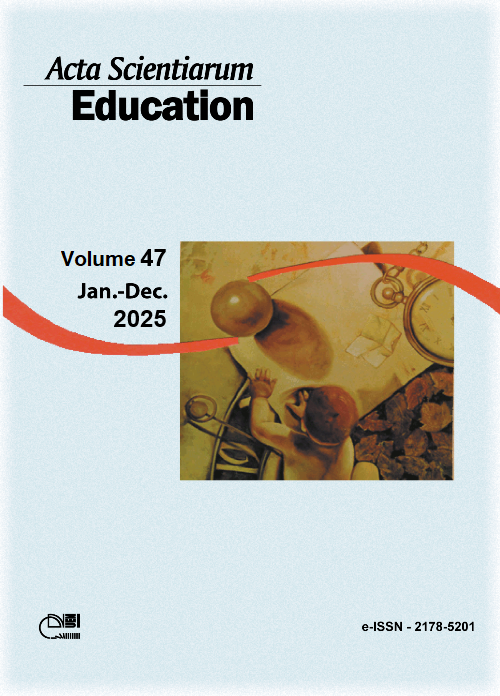Motivação de professores e conflito trabalho-família: percepções de professores da Fil-Am
Resumo
Este estudo foi realizado para investigar a relação entre a motivação e o conflito trabalho-família (WFC) vivenciado. A amostra consistiu de 105 professores filipino-americanos K-12 em Maryland, EUA. Os dados utilizados na pesquisa foram coletados eletronicamente por meio de uma Escala de Motivação e uma Escala de Conflito Trabalho-Família. Os resultados da escala de Motivação apresentaram média geral de 6,15 (DP = 0,75) com descrição qualitativa de concordo. Especificamente sobre fatores motivadores ou fatores que são de natureza intrínseca, os entrevistados postaram uma média combinada de 6,30 (DP = 0,63) com uma descrição qualitativa de concordo fortemente, enquanto nos fatores de higiene ou manutenção, os entrevistados tiveram uma média combinada de 5,99 (DP = 0,75 ) com uma descrição qualitativa de concordância, os entrevistados da Escala de Conflito Trabalho-Família revelaram que, em geral, os professores registraram uma pontuação média de 2,42 (DP = 1,15) de 5 possíveis. Os professores concordam moderadamente que experimentaram trabalho baseado em tempo e tensão interferência com a família (WIF) e interferência da família com base no trabalho (FIW). Eles postaram a resposta discordando que experimentaram FIW baseado em tempo e tensão, bem como qualquer uma das duas interferências baseadas em comportamento (WIF e FIW). A análise de correlação usando Pearson r mostrou que havia uma relação negativa altamente significativa entre fatores de higiene e WIF baseado em tensão, bem como entre fatores de higiene e WIF baseado em comportamento. Houve também uma relação negativa entre fatores de higiene e FIW baseado em comportamento. Isso significa que, à medida que as necessidades de manutenção estão sendo atendidas (ou seja, salários, condições de trabalho favoráveis, etc.), os professores se sentem mais energizados quando fazem a transição das funções de trabalho para as funções familiares. Além disso, atender a essas necessidades incentiva os professores a cumprir as expectativas de comportamento, portanto, a intrusão de outros papéis. Não houve relação entre os fatores motivadores e todas as seis categorias do WFC. Da mesma forma, entre fatores de higiene e interferências baseadas em tempo (WIF e FIW), bem como entre fatores de higiene e FIW baseado em tensão.
Downloads
Referências
Aguilar, E. (2020). Coaching with equity: Conversations that change practice. Jossey Bass. A Wiley Brand.
Akdemir, E. (2020). The determination of teachers’ motivation based on Herzberg’s motivation theory. Turkish Online Journal of Educational Technology, 19(4), 89-101. https://eric.ed.gov/?id=EJ1272850
Amin, S., Mukminin, A., Setiawati, R., & Fitriaty, F. (2021). Empowering leadership and human resources through stimulating innovative behaviors in higher education. Zbornik Radova Ekonomskog Fakultet Au Rijeci, 39(2), 381-399. https://doi.org/10.18045/zbefri.2021.2.381
Ataliç, H., Can, A., & Cantürk, N. (2016). Herzberg’s motivation-hygiene theory applies to high school teachers in Turkey. European Journal of Multidisciplinary Studies, 1(4), 90-97. 10.26417/EJMS.V1I4.P90-97
Bakar, Z. A., & Salleh, R. (2015). Role demands, work-family conflict and motivation: A proposed framework. Global Business and Management Research: An International Journal, 7(2), 78-87. http://www.gbmrjournal.com/pdf/vol.%207%20no.%202/V7N2-10.pdf
Bassi, M., & Fave, A. D. (2012). Optimal experience among teachers: new insights into the work paradox. The Journal of Psychology, Interdisciplinary and Applied, 146(5), 533-557. https://doi.org/10.1080/00223980.2012.656156
Bellavia, G., & Frone, M. R. (2005). Work-family conflict. In J. Barling, E. K. Kelloway, & M. R. Frone (Eds.), Handbook of work stress (pp. 113-148). Sage Publications.
Bernas, K. H. (2002). Time-based work -family conflict: Myth or reality? [Dissertation of Degree of Doctor of Philosophy, Faculty of Old Dominion University]. https://digitalcommons.odu.edu/cgi/viewcontent.cgi?article=1086&context=psychology_etds
Best, J. W., & Kahn, J. V. (2014). Research in education. Pearson New International Education.
Carlson, D. S., Kacmar, K. M., & Williams, L. J. (2000). Construction and validation of a multidimensional measure of work–family conflict. Journal of Vocational Behavior, 56(2), 249-276. https://doi.org/10.1006/jvbe.1999.1713
Charkhabi, M., Sartori, R., & Ceschi, A. (2016). Work–family conflict based on strain. Work-family conflict based on strain: The most hazardous type of conflict in Iranian hospitals nurses. SA Journal of Industrial Psychology, 42(1), 1-10. https://doi.org/10.4102/sajip.v42i1.1264
Chiang, I.-C. A., Jhangiani, R. S., & Price, P. C. (2015). Research Methods in Psychology. Victoria, B.C. https://opentextbc.ca/researchmethods/
Cinamon, R. G., & Rich, Y. (2002). Gender differences in the importance of work and family roles: Implications for work-family conflict. Sex Roles, 47, 531-541. https://doi.org/10.1023/A:1022021804846
Citrawan, I. W., Widana, I. W., Sumandya, . I. W., Widana, I. N. S., Mukminin, A., Arief, H., & Meter, W. (2024). Special education teachers’ ability in literacy and numeracy assessments based on local wisdom. Jurnal Ilmiah Ilmu Terapan Universitas Jambi, 8(1), 145–157. https://doi.org/10.22437/jiituj.v8i1.32608
Clark, S. C. (2000). Work/family border theory: A new theory of work/family balance. Human Relations, 53(6), 747-770. https://doi.org/10.1177/0018726700536001
Cuddy, A. J. C., Fiske, S. T., & Glick, P. (2004). When professionals become mothers, warmth doesn’t cut the ice. Journal of Social Issues, 60(4), 701-718. https://doi.org/10.1111/j.0022-4537.2004.00381.x
Dulock, H. L. (1993). Research design: descriptive research. Journal of Pediatric Hematology/Oncology Nursing, 10(4), 154-157. https://doi.org/10.1177/104345429301000406
Eagle, B. W., Icenogle, M. L., Maes, J. D., & Miles, E. W. (1998). The importance of employee demographic profiles for understanding experiences of work-family interrole conflicts. The Journal of Social Psychology, 138(6), 690-709. http://dx.doi.org/10.1080/00224549809603255
Erdamar, G., & Demirel, H. (2016). Job and life satisfaction of teachers and the conflicts they experience at work and at home. Journal of Education and Training Studies, 4(6), 164-175. https://files.eric.ed.gov/fulltext/EJ1100365.pdf
Finnigan, K. S., & Gross, B. (2007). Do accountability policy sanctions influence teacher motivation? Lessons from Chicago’s low-performing schools. American Educational Research Journal, 44(3), 594-630. https://doi.org/10.3102/0002831207306767
Gokce, F. (2010). Assessment of teacher motivation. School Leadership & Management, 30(5), 487-499. http://dx.doi.org/10.1080/13632434.2010.525228
Greenhaus, J. H., & Beutell, N. J. (1985). Sources of conflict between work and family roles. The Academy of Management Review, 10(1), 76-88. https://doi.org/10.5465/AMR.1985.4277352
Han, J., & Yin, H. (2016). Teacher motivation: Definition, research development and implications for teachers. Cogent Education, 3(1), https://doi.org/10.1080/2331186X.2016.1217819
Harja, H., Mukminin, A., Muhaimin, M., Hidayat, M., Haryanto, E., Sari, S. R., & Fridiyanto, F. (2021). Voices from the frontliners: The case of motivations and challenges of mismatched women teachers in public secondary schools. Turkish Online Journal of Qualitative Inquiry, 12 (2), 201-221. https://doi.org/10.17569/tojqi.81888
Harwell, M. R. (2011). Research design in qualitative/quantitative/mixed methods. In C. Conrad, & R. C. Serlin (Eds.), The Sage handbook for research in education: Pursuing ideas as the keystone of exemplary inquiry (pp. 147-163). SAGE Publications.
Higgins, A. M. (2020). Work-life balance best practices [Doctoral Thesis, Walden University]. https://www.proquest.com/dissertations-theses/work-life-balance-best-practices/docview/2418583440/se-2
Hizon, O. J., Cruz, N.Y., Collantes, L.M., Torres, J.M., Mukminin, A., & Ibarra, F.P. (2024). The impact of concept cartoons as an instructional material and formative assessment tool in teaching evolution on the achievement of grade 11 stem students enrolled in synchronous modality. Jurnal Ilmiah Ilmu Terapan Universitas Jambi, 8(1), 170-179. https://doi.org/10.22437/jiituj.v8i1.32609
Hughes, A. L., Matt, J. J., & O’Reilly, F. L. (2015). Principal support is imperative to the retention of teachers in hard-to-staff schools. Journal of Education and Training Studies, 3(1), 129-134. http://dx.doi.org/10.11114/jets.v3i1.622
Jones, N. D., Camburn, E. M., Kelcey, B., & Quintero, E. (2022). Teachers’ time use and affect before and after covid-19 school closures. AERA Open, 1-3. https://doi.org/10.1177/23328584211068068
Kara, S. B. K., Günes, D. Z., & Tüysüzer, B. S. (2021). Work-family conflict during working from home due to pandemic: A qualitative research on female teachers. International Journal of Curriculum and Instruction, 13(1), 251-273. https://ijci.globets.org/index.php/IJCI/article/download/578/239/2272
Khalid, U. K. (2021). The impact of work-family conflict on job and life satisfaction for female executive MBA students. Journal of Education and Educational Development, 8(1), 180-193. http://dx.doi.org/10.22555/joeed.v8i1.437
Korabik, K., Lero, D. S., & Ayman, R. (2003). A multi-level approach to cross cultural work-family research: A micro and macro perspective. International Journal of Cross Cultural Management, 3(3), 289-303. https://doi.org/10.1177/1470595803003003003
Krantz-Kent, R. (2008). Teachers’ work patterns: When, where, and how much do U.S. teachers work. Monthly Labor Review, 52-59. https://www.bls.gov/opub/mlr/2008/03/art4full.pdf
Maeran, R., Pitarelli, F., & Cangiano, F. (2013). Work-life balance and job satisfaction among teachers. Interdisciplinary Journal of Family Studies, 18(1), 51-72. https://research.bond.edu.au/en/publications/work-life-balance-and-job-satisfaction-among-teachers
Mahmoodi-Shahrebabaki, M. (2020). The associations among literacy teachers' grade level, teaching experience, work-family conflict, burnout, and turnover intentions. [Dissertation of Degree of Doctor of Philosophy in Literacy Studies, Middle Tennessee State University].
Major, V., Klein, K., & Ehrhart, M. (2002). Work time, work interference with family, and psychological distress. Journal of Applied Psychology, 87(3), 427-436. https://doi.org/10.1037/0021-9010.87.3.427
Mariatini, N. K. S., Suryani, N. K., Agung, A. A. P., & Sapta, I. K. S. (2020). Work family conflict and work stress. International Journal of Disaster Recovery and Business Continuity, 11(3), 998-1012. http://sersc.org/journals/index.php/IJDRBC/article/view/32821
Masbirorotni, M., Mukminin, A., Muhaimin, Habibi, A., Haryanto, E., Hidayat, M., Marluzina, L., Harto, K., Erlina, D., & Kamil, D. (2020). Why student teachers major in english education: An analysis of motives for becoming future teachers. Journal of Elementary Education, 13(4), 429-451. https://doi.org/10.18690/rei.13.4.429-452.2020
Masuda, A. D., Sortheix, F. M., Beham, B., & Naidoo, L. J. (2019). Cultural value orientations and work–family conflict: The mediating role of work and family demands. Journal of Vocational Behavior,112, 294-310. https://doi.org/10.1016/j.jvb.2019.04.001
McCarthy, A., Darcy, C., & Grady, G. (2010). Work-life balance policy and practice: Understanding line manager attitudes and behaviors. Human Resource Management Review,20, 158-167. https://doi.org/10.1016/j.hrmr.2009.12.001
Michel, J.S., Kotrba, L. M., Mitchelson, J.K., Clark, M.C., & Baltes, B.B. (2011). Antecedents of work–family conflict: A meta-analytic review. Journal of Organizational Behaviour, 32(5), 689-725.
Moore, B. (2013). Flow theory and the paradox of happiness. In J. D. Sinnott (Ed.), Positive psychology: Advances in understanding adult motivation (pp. 35-42). Springer Science + Business Media. https://doi.org/10.1007/978-1-4614-7282-7_3
Mukminin, A., Kamil, D., Muazza, M., & Haryanto, E. (2017a). Why teacher education? documenting undocumented female student teachers’ motives in indonesia: A case study. The Qualitative Report, 22(1), 309-326. https://doi.org/10.46743/2160-3715/2017.2640
Mukminin, A., Rohayati, T., Putra, H. A., Habibi, A., & Aina, M. (2017b). The long walk to quality teacher education in Indonesia: EFL student teachers’ motives to become a teacher and policy implications. Elementary Education Online, 16(1), 35-59. https://doi.org/10.17051/io.2017.16366
National Center for Education Statistics. (2022). Report on the condition of education 2022. U.S. Department of Education. https://nces.ed.gov/pubs2022/2022144.pdf
Pardee, R. (1990). Motivation theories of Maslow, Herzberg, McGregor and McClelland. A literature review of selected theories dealing with job satisfaction and motivation (Literature Review). Education Resources Information Center [ERIC]. https://files.eric.ed.gov/fulltext/ED316767.pdf
Paradies, Y. (2016). Colonisation, racism and indigenous health. Journal of Population Research, 33(1), 83-96.
Reiger, R. C., & Rees, R. T. (1993). Teachers and their motivation values: Pre-existing personality or environmental traits? Educational Research Quarterly, 16(3), 11-21. https://eric.ed.gov/?id=EJ480439
Salkind, N. J. (2010). Encyclopedia of research design. SAGE Publications, Inc.
Schieman, S., Milkie, M. A., & Glavin, P. (2009). When work interferes with life: Work-nonwork interference and the influence of work-related demands and resources. American Sociological Review, 74(6), 966-988. http://www.jstor.org/stable/27801503
Shukr, I., Qamar, K., & Hassan, A. Ul (2016). Faculty perception of level of teacher motivation. Pakistan Armed Forces Medical Journal, 66(6), 784-789. https://www.pafmj.org/PAFMJ/article/view/919
Skiadas, G. (2020). Motivation - Hygiene Theory: Greek teacher’s attitude towards maintenance factors and motivators in school environment. Educ@tional Circle. Scientific Educational Journal, 8(1), 19-37. https://journal.educircle.gr/el/59-teyxi-periodikon/tomos-8-teyxos-1/575-motivation-hygiene-theory-greek-teacher-s-attitude-towards-maintenance-factors-and-motivators-in-school-environment
Smith, T. D., Yu, Z., & Le, A. B. (2020). An examination of work interference with family using data from a representative sample of workers participating in the General Social Survey and NIOSH Quality of Worklife module. Journal of Family Issues, 41(12), 2356-2376. https://doi.org/10.1177/0192513X20927758
Smith, W. K., Erez, M., Jarvenpaa, S. L., Lewis, M., & Tracey, P. (2017). Adding complexity to theories of paradox, tensions, and dualities of innovation and change: Introduction to organization studies special issue on paradox, tensions, and dualities of innovation and change. Organization Studies, 38(3-4), 303-317. https://doi.org/10.1177/0170840617693560
Souza, C., Pinto, E., Santos, J., & Gonçalves, G. (2020). Effects of work-family and family-work conflict and guilt on job and life satisfaction. Polish Psychological Bulletin, 51(4), 305-314. https://doi.org/10.24425/ppb.2020.135463
Steiner, E. D., & Woo, A. (2021, 15 June). Job-related stress threatens the teacher supply. Key findings from the 2021 state of the US teacher survey. Research and Commentary. Rand Corporation. https://www.rand.org/pubs/research_reports/RRA1108-1.html
Tang, S. Y, F., Wong, P. M., Wong, A. K. Y., & Cheng, M. M. H. (2018). What attracts young people to become teachers? A comparative study of pre-service student teachers’ motivation to become teachers in Hong Kong and Macau. Asia Pacific Education Review, 19, 433-444. https://doi.org/10.1007/s12564-018-9541-x
Tawil, M. A. (2008). Carrying out mandated school efforts: A phenomenological study of New York teachers' morale and motivations [Doctoral Thesis, Northcentral University].
Ulucan, H. (2017). Relationship between job satisfaction levels and work-family conflicts of physical education teachers. Journal of Education and Learning 6(3), 312-322. https://doi.org/10.5539/jel.v6n3p312
Wepfer, A. G., Allen, T. D., Brauchli, R., Jenny, G. J., & Bauer, G. F. (2018). Work-life boundaries and well-being: does work-to-life integration impair well-being through lack of recovery? Journal of Business and Psychology, 33, 727-740. https://doi.org/10.1007/s10869-017-9520-y
Wong, H. K., & Wong, R. T. (1998). The first days of school: How to be an effective teacher. Harry K. Wong Publications, Inc.
Yunita, P. I., & Kismono, G. (2014). Influence of work-family conflict and family-work conflict on employees’ turnover intentions with gender, social support and individual value as moderating effects. Journal of Indonesian Economy and Business, 29(1), 17-31. https://doi.org/10.22146/jieb.6210
This work is licensed under a Creative Commons Attribution 4.0 International License.
DECLARAÇÃO DE ORIGINALIDADE E DIREITOS AUTORAIS
Declaro que o presente artigo é original, não tendo sido submetido à publicação em qualquer outro periódico nacional ou internacional, quer seja em parte ou em sua totalidade.
Os direitos autorais pertencem exclusivamente aos autores. Os direitos de licenciamento utilizados pelo periódico é a licença Creative Commons Attribution 4.0 (CC BY 4.0): são permitidos o compartilhamento (cópia e distribuição do material em qualquer suporte ou formato) e adaptação (remix, transformação e criação de material a partir do conteúdo assim licenciado para quaisquer fins, inclusive comerciais).
Recomenda-se a leitura desse link para maiores informações sobre o tema: fornecimento de créditos e referências de forma correta, entre outros detalhes cruciais para uso adequado do material licenciado.














































